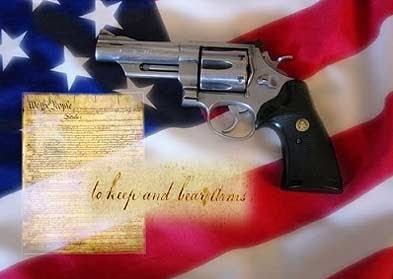 Published with permission of Richard Hamblen:
Published with permission of Richard Hamblen:Brief Introduction to
Hamblen vs United States
(09-9990)
Richard A. Hamblen was a commissioned officer in the state militia of Tennessee, the Tennessee State Guard, and battalion commander of the 201st Military Police Battalion. He committed an act of civil disobedience by defying the National Firearms Act of 1934 and building for his use, and the use of the soldiers in his command, firearms that are, in the words of the United States Supreme Court, in United States vs Miller, “part of the ordinary military equipment... of the type in common use at the time, which could reasonably contribute to the common defense”.
Hamblen was tried and convicted in 2006 for violating the NFA of 1934 and the 922(o) laws. He served 13 months in federal prison, and 24 months of probation. His case was appealed to the Supreme Court at the exact same time as Heller vs DC. Certiorari was denied without comment. In December of 2008, Hamblen filed a petition for writ of habeas corpus, in which US District Court Judge Todd Campbell said Hamblen “made a substantial showing of the denial of his constitutional rights as regards his Second Amendment claim”. The case is now once again before the Supreme Court.
Question presented to the Court:
“Whether the Second Amendment Guarantees Members Of A Legitimate State Authorized Militia The Right To Keep And Bear Arms Supplied by Themselves Of The Kind In Common Use By The Military At The Time”
“Whether the Second Amendment Guarantees Members Of A Legitimate State Authorized Militia The Right To Keep And Bear Arms Supplied by Themselves Of The Kind In Common Use By The Military At The Time”
Hamblen's argument is this:
1. Hamblen's case is the first Second Amendment case to be presented to the Court involving an actual member of a statutorily created state militia, and should be accepted for this reason.
2. The Heller decision contradicts the Court's earlier ruling in Miller by selectively quoting from Miller. Heller claims that, according to Miller, the Second Amendment protects only those arms which are “in common use at the time”. The actual quote is “part of the ordinary military equipment of the type in common use at the time, which could reasonably contribute to the common defense”. Only the Supreme Court can resolve the conflict between the two cases.
3. Heller gets the facts of Miller wrong. Heller states that Miller and his codefendant appealed their conviction for violating the NFA of 1934. In truth, it was the government appealing the dismissal of the charges against the two. The surviving defendant in Miller was not even represented in the Supreme Court. The Court nevertheless did not accept the prosecution's argument, but said, rather, in the “absence of any evidence” in the trial record that the weapon in question was “part of the ordinary military equipment, of the type in common use at the time, which could reasonably contribute to the common defense”, they could not say the Second Amendment protected it and the case was remanded to the original jurisdiction for further discovery to expand the record. The surviving defendant, instead of introducing the evidence to meet the standard set by the Court, obligingly plead guilty in exchange for a sentence of probation.
4. The United States is prevented by the Constitution from exercising any authority over the Militia, unless and until the Militia is in the actual service of the United States. Under all other circumstances the Militia is under the jurisdiction of the “several states”. Furthermore, the Second Amendment, adopted in 1791, overrides any authority over arms claimed by the United States under any provision of the 1787 Constitution, just as the 13th Amendment removes any protections for chattel slavery found in the 1787 Constitution. The Militia is the only institution named by the Constitution as “necessary for the security of a free state”. The purpose of the Second Amendment is, as Miller says, to preserve and maintain the efficiency of the Militia. For the United States to do anything to impair this goal defeats the purpose of the Second Amendment, and, since the Constitution cannot be internally contradictory, such action is nonsensical.
Hamblen vs United States deserves the consideration and support of all who claim to defend the Second Amendment. Given the circumstances of his case, if Hamblen is not protected by the Second Amendment, then no one is.
Richard A. Hamblen may be contacted at:
510 Houston Street
Nashville, TN 37203
(615) 438-2397
rahamblen@gmail.com
Nashville, TN 37203
(615) 438-2397
rahamblen@gmail.com
The case documents are at: http://www.esnips.com/web/HamblenvsUnitedStates

